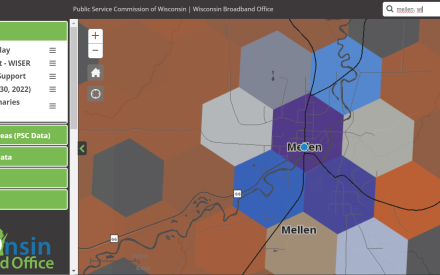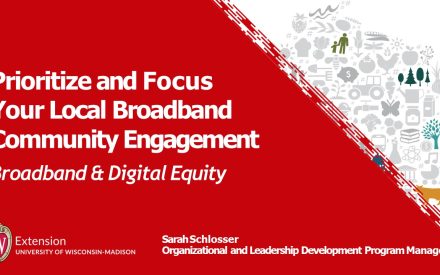REGIONAL DEVELOPMENT & COMMUNITY WELL-BEING
Research has consistently found a strong positive relationship between internet access, particularly broadband, and economic growth and development. Studies that focus on more rural areas within the U.S. find that access to broadband is important in attracting new businesses, fostering entrepreneurship, enhancing farm profits, and even increasing the value of rural housing. It is clear that access to the internet and broadband in particular is no longer a luxury, but a necessary condition for regional economic growth and development.
Population and Employment
Anecdotally, a lack of broadband can be a constraint on population and employment growth. As population growth and employment growth themselves are correlated, a lack of broadband could affect growth in several directions. For example:
Population and Employment: Many communities across Wisconsin have adopted economic growth and development strategies that fall under the umbrella of “place-making.” Historically, people have followed jobs: create employment opportunities and people will move into the community to take advantage of those jobs. Today, for some types of labor markets, especially in occupations requiring high knowledge levels, the flow has largely changed to where jobs now appear to be following people. Here, creating a community environment that is attractive to young families, young professionals, and even retirees comes to the forefront. Baileys Harbor in Door County, for example, has attempted to encourage young professionals to relocate there by marketing its quality broadband, which is essential to this kind of place-making strategy, in addition to its natural amenities.
- If communities are attempting to attract new residents with the perspective that jobs follow people, new residents may be reluctant to move to particular regions of the state without broadband access.
- Similarly, when choosing between two otherwise similar communities, people may select to relocate to the one with more readily available broadband.
- In contrast, if communities are attempting to create new employment opportunities with the viewpoint that people follow jobs, it is possible that a lack of broadband could constrain job growth and deter new residents from moving into a community.
- In particular, businesses in rural communities without access to online markets, suppliers, and productive technologies are at a disadvantage which could result in lower levels of job growth.
Education
Educational and professional development opportunities, whether formal or informal, increasingly depend on access to the internet and broadband. These opportunities could include formal online classes (distance education), professional development seminars and online workshops, or self-motivated desires to learn something new or different. Indeed, businesses that invest in new technologies or pieces of equipment are finding that access to broadband is necessary as more vendors move documentation to online-only formats.
Educational attainment is only one way to measure how access to the internet and broadband impacts the development of human capital within the community. With the closure of Wisconsin schools due to COVID-19, all classroom learning moved online during the 2020 spring semester. While educators are currently discussing the effectiveness of such a learning format for K-12 students, particularly elementary school students, access to affordable broadband is required to equitably offer this online learning alternative. Teachers and parents are discovering numerous learning opportunities that are available online beyond resources made available by the student’s school. But again, access to affordable broadband is necessary. The push for online learning motivates the question of a link between broadband access and student outcomes in the form of testing scores.
Health Outcomes
The final relationship we consider is the connection of broadband to community well-being in terms of health outcomes. The link between broadband and health care is often considered through the lens of telehealth where patients can access medical health practitioners through web conferencing (e.g., Jennett 2003). Increasingly, practitioners can conduct in-house visits and access necessary technologies through the internet. These connections, however, require broadband-level speeds and consistent connection quality.
Health outcomes can also increase through access to health care information such as internet-based counseling, coaching, and educational materials. The potentially growing link between broadband and health outcomes is a growing concern for many communities that lack access to the internet and broadband as it is widely accepted that individual health has both direct and indirect impacts on labor productivity and, hence, the economy (Deller 2020).
“…a lack of access to the internet and broadband could be associated with higher levels of fair to poor health and a higher number of poor mental health days…”
WHERE DO WE GO FROM HERE?
There are significant pockets of Wisconsin where broadband internet is unavailable or insufficient. This lack of access is a combination of both the lack of physical infrastructure as well as cost barriers for lower-income individuals and households. That is, infrastructure alone will not solve broadband internet access problems. From an economic growth and development position, access to high-speed, reliable, and inexpensive broadband has become necessary. Broadband is no longer a luxury. Communities across Wisconsin are aware of this and are working diligently to address local shortcomings to broadband access. There are federal and statewide strategies and policies that could encourage broadband access. However, communities, regions, and the State of Wisconsin must consider and implement effective strategies that reflect local conditions.
Broadband Access: Many households in rural areas have below-average access to broadband, likely reflecting a lack of sufficient infrastructure. These areas may want to prioritize strategies and policies that encourage the development of physical resources needed to provide access.
Broadband Adoption: Finally, data suggest high levels of broadband availability and a high share of households without internet in areas that could be affected by a lack of broadband adoption by households. These areas and households could choose to implement outreach and education strategies that note the benefits of broadband and encourage its use to help increase take rates.
Broadband Affordability: There is data that has high levels of reported broadband availability, but also has a higher-than-average percentage of households without internet. These are often found in lower-income areas, such as many census tracts in the City of Milwaukee, in the City of Madison, and in Racine and Brown Counties. These areas may need to consider policies that make broadband more affordable. Many areas may need to consider policies that make broadband more affordable but also make broadband infrastructure more available.











 What's Next in Wisconsin Broadband, December 2025
What's Next in Wisconsin Broadband, December 2025 Broadband Expansion in Wisconsin: Case Studies - Page 3
Broadband Expansion in Wisconsin: Case Studies - Page 3


